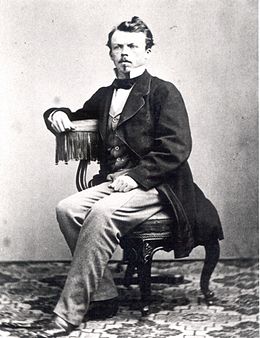Albert Oppel
Carl Albert Oppel (born December 19, 1831 in Hohenheim , Stuttgart , † December 22, 1865 in Munich ) was a German paleontologist who made significant contributions to the study of the geological period of the Jura .
life and work
Oppel, son of the agricultural scientist and government councilor Julius Albert Oppel (1799-1882), studied from 1851 at the University of Tübingen under Friedrich August von Quenstedt and received his doctorate in 1853 by solving the prize question "About the middle Lias of Swabia". In 1854 and 1855 he went on research trips to the then known Jurassic sites in France, England, Switzerland and Germany. He presented the results of his research from 1856 to 1858 in the work The Jura Formation of England, France and Southwestern Germany .
In 1858 he became professor of palaeontology at the University of Munich , in 1861 he was appointed full professor and, in succession to Johann Andreas Wagner, curator of the Paleontological Museum in Munich . In 1862 he was appointed an extraordinary member of the mathematical-physical class of the Bavarian Academy of Sciences . From 1862 he was also editor and co-author of the palaeontological reports he founded .
He divided the Jura into 36 biostratigraphic "zones". With this term, which he introduced (today Biozone ), Oppel refined the classification of levels . The Jurassic level names Pliensbachium and Tithonium that he introduced are now internationally recognized.
On the moon, the Dorsum Oppel ("Oppel-Ridge") mountains are named after him. In 2004, Günter Schweigert and Alessandro Garassino named the fossil shrimp genus Albertoppelia from the tithonium of Eichstätt ( Solnhofen limestone ) after Oppel, whose monograph on the decapods of the southwestern German Jura is still the most comprehensive work on this topic.
His son was the doctor and histologist Albert Otto Oppel (1863-1916).
Fonts
- The middle Lias of Swabia. Ebner & Seubert, Stuttgart 1853. Google
- with E. Suess: About the presumed equivalents of the Kössen strata in Swabia. In: Meeting reports of the Imperial Academy of Sciences 21, 1, Vienna 1856, pp. 535–549, 2 plates
- The Jura formation of England, France and southwestern Germany. Divided and compared according to their individual members. Ebner & Seubert, separate reprint of the Württemberg natural science annual books. 12-14 Vol., Stuttgart 1856-1858. Google
- Further evidence of the Kössen layers in Swabia and Luxembourg. In: Meeting reports of the Imperial Academy of Sciences 26, year 1857, 1, Vienna 1858, pp. 7–13
- The more recent investigations on the zone of the Avicula contorta with special consideration of A. Martin's observations on the occurrence of this zone in the Dep. Cote d´Or. In: Annual books of the Association for Patriotic Natural History in Württemberg, 15, Stuttgart 1859, pp. 315-325
-
Palaeontological reports from the museum of the royal. bayer. State . Ebner & Seubert, Stuttgart 1862, Text Google and Atlas Google
- I. About Jurassic Crustaceans
- II. About tracks in lithographic slate
- III. About Jurassic cephalopods
literature
- Johann Gottlob von Kurr : Necrology of Professor Dr. Albert Oppel , in: Annual Books of the Association for Patriotic Natural History in Württemberg , 23rd year, E. Schweizerbart, Stuttgart 1867, p. 26f.
Individual evidence
- ↑ Günter Schweigert: "When genius and hard work combine - Albert Oppel (1831-1865)". In: fossils . Issue 2, March / April 2008, p. 90
- ^ Günter Schweigert & Alessandro Garassino (2004): "New genera and species of shrimps (Crustacea: Decapoda: Dendrobranchiata, Caridea) from the Upper Jurassic lithographic limestones of S Germany". In: Stuttgart Contributions to Natural History - Series B, No. 350: 33 pp. Article (PDF; 2.4 MB)
Web links
- Günter Schweigert: Albert Oppel (1831-1865) - a life far too short for paleontology ( Memento from July 26, 2010 in the Internet Archive )
- Helmut Mayr: Oppel, Albert. In: New German Biography (NDB). Volume 19, Duncker & Humblot, Berlin 1999, ISBN 3-428-00200-8 , pp. 556 f. ( Digitized version ).
- Wilhelm von Gümbel: Oppel, Albert . In: Allgemeine Deutsche Biographie (ADB). Volume 24, Duncker & Humblot, Leipzig 1887, pp. 388-390.
| personal data | |
|---|---|
| SURNAME | Oppel, Albert |
| ALTERNATIVE NAMES | Oppel, Carl Albert |
| BRIEF DESCRIPTION | German paleontologist |
| DATE OF BIRTH | December 19, 1831 |
| PLACE OF BIRTH | Hohenheim |
| DATE OF DEATH | December 22, 1865 |
| Place of death | Munich |
